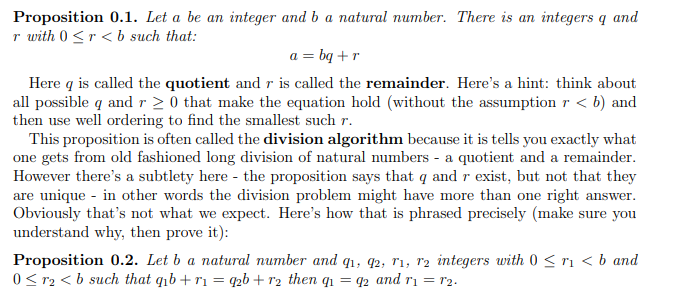Proposition 0.1. Let a be an integer and b a natural number. There is an integers q and r with 0
Proposition 0.1. Let a be an integer and b a natural number. There is an integers q and r with 0
College Algebra
7th Edition
ISBN:9781305115545
Author:James Stewart, Lothar Redlin, Saleem Watson
Publisher:James Stewart, Lothar Redlin, Saleem Watson
ChapterP: Prerequisites
SectionP.2: Real Numbers
Problem 1E: Give an example of each of the following: (a) A natural number (b) An integer that is not a natural...
Related questions
Question

Transcribed Image Text:Proposition 0.1. Let a be an integer and b a natural number. There is an integers q and
r with 0 <r < b such that:
a = bq +r
Here q is called the quotient and r is called the remainder. Here's a hint: think about
all possible q and r 2 0 that make the equation hold (without the assumption r < b) and
then use well ordering to find the smallest such r.
This proposition is often called the division algorithm because it is tells you exactly what
one gets from old fashioned long division of natural numbers - a quotient and a remainder.
However there's a subtlety here - the proposition says that q and r exist, but not that they
are unique - in other words the division problem might have more than one right answer.
Obviously that's not what we expect. Here's how that is phrased precisely (make sure you
understand why, then prove it):
Proposition 0.2. Let b a natural number and q1, q2, r1, r2 integers with 0 < ri < b and
0 < r2 < b such that qib+ r1 = q2b+ r2 then qi = q2 and ri = r2.
Expert Solution
This question has been solved!
Explore an expertly crafted, step-by-step solution for a thorough understanding of key concepts.
Step by step
Solved in 2 steps with 2 images

Recommended textbooks for you

College Algebra
Algebra
ISBN:
9781305115545
Author:
James Stewart, Lothar Redlin, Saleem Watson
Publisher:
Cengage Learning

College Algebra (MindTap Course List)
Algebra
ISBN:
9781305652231
Author:
R. David Gustafson, Jeff Hughes
Publisher:
Cengage Learning

Algebra & Trigonometry with Analytic Geometry
Algebra
ISBN:
9781133382119
Author:
Swokowski
Publisher:
Cengage

College Algebra
Algebra
ISBN:
9781305115545
Author:
James Stewart, Lothar Redlin, Saleem Watson
Publisher:
Cengage Learning

College Algebra (MindTap Course List)
Algebra
ISBN:
9781305652231
Author:
R. David Gustafson, Jeff Hughes
Publisher:
Cengage Learning

Algebra & Trigonometry with Analytic Geometry
Algebra
ISBN:
9781133382119
Author:
Swokowski
Publisher:
Cengage

Algebra: Structure And Method, Book 1
Algebra
ISBN:
9780395977224
Author:
Richard G. Brown, Mary P. Dolciani, Robert H. Sorgenfrey, William L. Cole
Publisher:
McDougal Littell